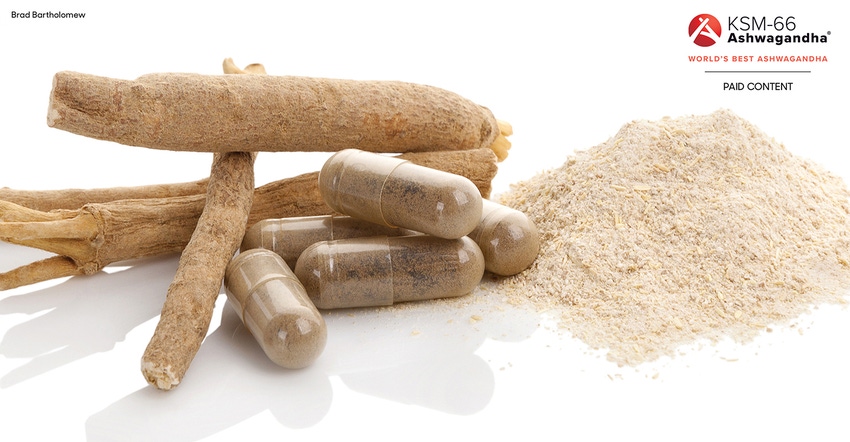Let herbs be herbs: Remembering why consumers want natural ingredients – article
Standardizing herbal extracts to specific molecules is often contrary to traditional methods and some believe it may diminish the therapeutic effect that nature intended.
November 28, 2023

Sponsored by KSM-66
There's a growing trend, unsettling for some, where some ingredient manufacturers are promoting that professionals assess herbal ingredients using standards set for single-entity application. Why is this cause for concern? It's because viewing botanical ingredients in a model similar to pharmaceutical drugs overlooks the main reason consumers and natural remedy practitioners opt for herbal ingredients: They desire them in the form that Mother Nature intended, evolving alongside humans over time and supporting human health. This stems from concerns that pharmaceutical synthesized compounds are not seen in nature and are not rooted in traditional long-term health practices, whereas natural ingredients are often sought as an alternative to medications, and to complement health.
The industry generally acknowledges this basic driver of consumer demand for botanical remedies, and the scientific rationale for preferring natural ingredients and broad-spectrum extracts. Therefore, when a new botanical category emerges it often is dominated by whole herbs and full spectrum extracts. As the segment develops and becomes competitive, however, emerging suppliers face the challenge of driving sales by touting benefits. At times, these proclaimed benefits may be overly promotional, or exaggerations that divert from the industry's core objectives. For example, as mentioned earlier, some manufacturers encourage professionals to assess herbal ingredients using standards meant for single-entity medications, the most significant of which is an extremely high concentration of particular molecules.
Focusing on specific molecules in herbs and emphasizing their importance can be concerning for several reasons. This trend is evident when ingredient providers emphasize their products based on claims about molecule concentration or their bioavailability. The approach is concerning because it challenges the foundational ideals motivating individuals to pursue herbal ingredients and could compromise the industry's main premise. Consider the subsequent reasons consumers might be sceptical about ingredient forms that emphasize specific molecules:
Alteration of natural form—Herbal ingredients are appreciated in their original natural form, embodying a mixture of numerous naturally present compounds acting in synergy. By accentuating excessively high concentrations of specific molecules or chemicals, this method skews the inherent essence of these natural remedies, potentially resulting in an unbalanced therapeutic effect.
Discrepancy with traditional use—The traditional application of herbal remedies frequently rests on the belief that the efficacy and safety of these ingredients arise from their natural constitution. Some consumers of natural remedies, and practitioners that recommend them, may opt for herbal components because of their congruity with compounds synthesized within the human body, and because their traditional use over time shows them to be safe. When manufacturers engage in the evaluation of botanical ingredients utilizing criteria intended for single-molecule drugs, they may inadvertently overlook the traditional wisdom that has directed the utilization of these remedies for generations.
Confusion and distraction in marketing and promotion
Ashwagandha presents a robust case study of the exact sort of marketing perplexity and hype generated by new ingredient manufacturers striving for a market presence. Ashwagandha, scientifically known as Withania somnifera, has been employed in traditional medicine for millennia. Notably, it is solely the root of the plant and root extracts that have been traditionally utilized and broadly documented for their extensive efficacy in promoting health and wellness. The root's distinct proportion of bioactive compounds is presumed to facilitate its varied health-promoting properties.
Nevertheless, as demand for ashwagandha root supplements surged, several ingredient manufacturers have resorted to making marketing assertions based on elevated levels of particular molecules like withanolides. They derive the withanolides from alternative plant parts like leaves, which in traditional use are considered undesirable for various reasons. Furthermore, some ingredient manufacturers allege higher bioavailability of these molecules, which may not necessarily be the fundamental contributors to the herb's efficacy. While withanolides might indeed be significant phytochemicals present in the root, it is crucial to comprehend that they are probably just a segment of the intricate blend that renders ashwagandha beneficial. Thus, a notably high presence of those molecules in the body does not inevitably translate to increased effectiveness of the component. Additionally, withanolides located in the root are not inevitably identical to the withanolides present in other plant sections like leaves. A vital observation here is that escalating specific molecules like withanolides to remarkably high levels, especially those extracted from the leaves, does not necessarily yield a product that aligns with the ashwagandha root consumable that has been utilized for generations.
Due to several of these concerns, the Government of India recently issued an advisory, advocating for the employment of ashwagandha roots only and recommending manufacturers avoid utilizing ashwagandha leaves. A primary impetus for this advisory seems to be the absence of extensive safety and efficacy data on ashwagandha leaves, to a degree comparable to the data available for the ashwagandha root.
All of this serves as an important consideration for industry stakeholders about the significance of maintaining natural ingredients in their original state and not transforming them into specific molecules analogous to drugs. For herbs, the industry should be vigilant about marketing claims that steer down a path that is not time tested through traditional use and knowledge. Today, it is unclear that high levels of withanolides alone, especially from non-standard plant parts like leaves, will deliver health impacts for the human body with the same level of safety and efficacy as time-honored ashwagandha root extracts.
You May Also Like




.png?width=800&auto=webp&quality=80&disable=upscale)